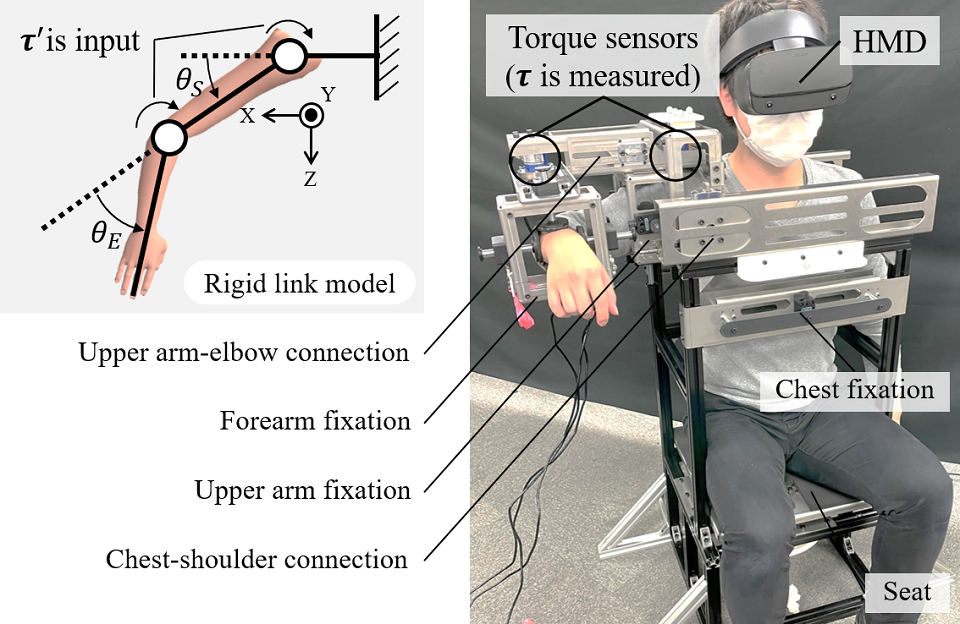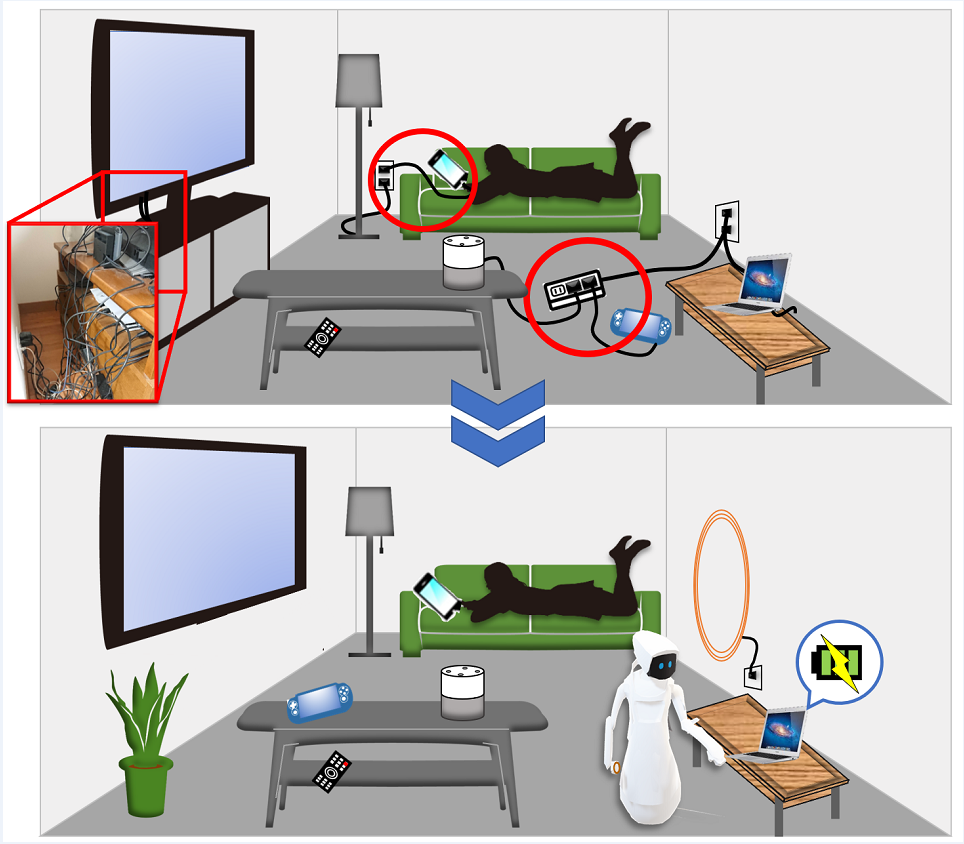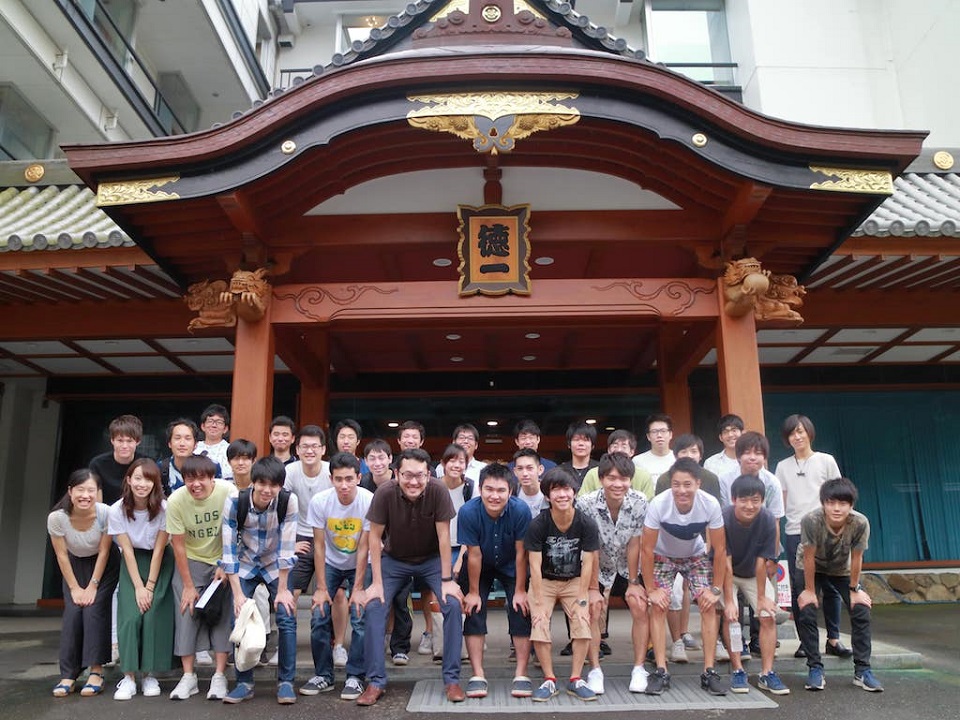reseach
Robotics for a future with free mobility in virtual reality
Sousuke Nakamura, Associate Professor
Department of Electrical and Electronic Engineering, Faculty of Science and Engineering
Posted Jan.7,2022
Faculty Profile
Sousuke Nakamura, Associate Professor, has been working to find ways of using robotics to expand human capabilities and support human activities. He has also been studying electrical power infrastructure to realize an automatic cordless power supply system.
Robotics to expand human capabilities and support human activities
I have been studying ways of using robot technology to expand human capabilities and support human activities. Human augmentation is a technology to supplement and enhance people’s capabilities, while assistive robotics is a technology to work on behalf of people to support their activities and lives.
As a technology for expanding human capabilities (i.e. Human augmentation), I have been working to realize a motionless virtual-reality (VR) system that allows the user to move around in the world of virtual reality while sitting still. With sensors attached to the user's body, the system detects the signs of a movement the user will make and gives the user a false perception that tricks the brain into having made the movement. You may be anxious that the user would feel physical unease even though the movement is reproduced by computer graphics. This difficult problem is solved by utilizing a human mechanism in which the angle of a joint is perceived on the basis of expansion of the muscle. I have succeeded in reproducing the expansion of the muscle via external stimuli such as vibrations, leading the person to feel a certain sense of motion (Fig. 1).
Another topic I'm working on is electrical power infrastructure that automatically provides equipment with electrical power that is indispensable for operation. I'm thinking of realizing this system by combining an automatic cordless power supply and an autonomous mobile robot. Just like a robot vacuum that sweeps out a room, a robot with a cordless charge feature would move throughout the living space and automatically supply power to electric appliances there (Fig. 2). I want to have a working prototype* of the robot in about five years and to exclude all cords from my laboratory.
*A prototype is the first form or trial model of a product that is made before it is mass-produced.

(Fig.1) Motionless VR system attached to an arm. The system detects signs of movement the wearer is going to make and tricks the wearer's brain into having made the movement.

(Fig.2) Autonomous mobile robot sweeps power cords out of the living space. The robot has cordless power charge function as well as automatic operation function.
Expectations on Hosei's free research environment through the integration of humanities and sciences
Since I was a student, I had entertained ideas of taking on large-scale challenges such as building social infrastructure. I was once employed at a startup because I expected that they would have an open atmosphere and let me plan and take part in new projects easily. However, I noticed that I could not accomplish my work without studying over time or repeating one trial and error after another. I decided to take my career in research to the university environment.
I took up my post at Hosei University through a happy turn of events. I was really quite amazed at the great diversity of research being done by the teaching staff in the Faculty of Science and Engineering. I am grateful for the benefits derived from the research environment there. All kinds of research activities are encouraged, and my preference for taking ample time with my work is respected.
I can easily imagine that Hosei's other faculties would also have a similarly favorable research environment. At Hosei University, which has as many as fifteen faculties, I think it is possible that specialists in different fields can work in cooperation without barriers between the faculties, despite humanities and sciences often being separated in Japan. I myself have studied the expansion of human capabilities with Shigeki Izumi, Professor in the Faculty of Sports and Health Studies. The distance between the three campuses could be a barrier to cooperative studies, but I look forward to the integration of humanities and sciences at Hosei.
Hoping students will understand the world and grow through their studies
As an educator, I expect that graduates going out into the world will have learned general knowledge and business knowledge as well as the basics of manufacturing.
If you know market mechanisms and customers' attitudes, you will get to thinking what kind of product sells. You are not obliged to make a product that will sell, but if nobody wants to buy it, a product will not be used. You may have a strong determination to make a good product, but your research budget is limited. Cost consciousness is important. I have been continuing my research work with a view to affect the course of world affairs someday. It is important to know what people need.
I instruct my students to consider their aims at first when they start their studies. What do they want to realize? Does their study help people? They should attach priority to the realization of products in great demand by many people. If they are lacking in skills, they should acquire the skills needed to realize the product. They should also obtain cooperation from the outside, if necessary.
I want my students to know the world by direct experience. So, I provide opportunities for them to participate in joint research with businesses and to listen to informative talks by researchers working at the front lines of businesses. Their convincing stories detailing actual experiences surely impact the students in a positive way.
I hope that my students will know the system of the world and draw their own picture of what they will do in the future. They should not be satisfied with easy solutions like those that can be found on the Web, but instead struggle awkwardly to find their own solution. Through their struggle, they will acquire a variety of capabilities, such as perseverance and intelligence. With this practical wisdom in-hand, they can improve themselves.

Pictures taken at a summer program of the laboratory in 2018. Participants gave research presentations first, and then had a barbecue and did some sightseeing. The event offers participants an opportunity to exchange their views while having fun.
Sousuke Nakamura, Associate Professor
Department of Electrical and Electronic Engineering, Faculty of Science and Engineering
Born in 1982. Bachelor’s degree, Department of Electrical Engineering, Faculty of Engineering, The University of Tokyo. Master’s degree in electronic engineering and Master’s degree in electrical engineering, the Department of Electrical Engineering and Information Systems, Graduate School of Engineering, The University of Tokyo. Ph. D. in Engineering. Elysium Co. Ltd. Assistant Professor, the Faculty of Science and Engineering, Chuo University. Took up a post as a full-time lecturer in 2016 and was promoted to Associate Professor in 2018 in the Department of Electrical and Electronic Engineering at the Faculty of Science and Engineering, Hosei University.

